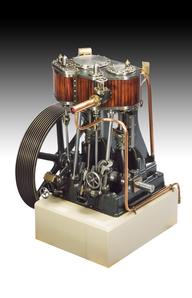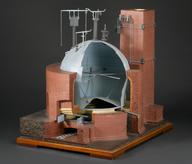

Vacuum Gauge by Boulton and Watt
- Made:
- 1794 in England and Birmingham






Vacuum gauge associated by Boulton and Watt, for measuring the pressure in the cylinder or condenser of their steam engines.
The steam engines built by Boulton and Watt used steam at very low pressures - only 2-3psi above atmospheric, and much of the engine's useful work was done by vacuum,. generated by the admission of steam to the condenser. This gauge was made to measure the vacuum present inside each engine as it worked. Readings from this gauge would have been taken by eye from the movememnt of the pointer against the scalboard above, the cylinder being connected to the engine. Later, John Southern improved the design ino the engine indicator, which allowed the steam pressure and vacuum to be recorded during the complete working cycle.
Details
- Category:
- Motive Power
- Object Number:
- 1876-1260
- Measurements:
-
overall: 1050 x 345 x 227 mm
overall weight:
- type:
- vacuum gauges
- credit:
- James Watt and Company




